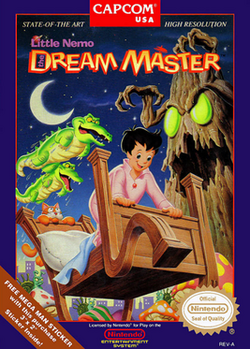Little Nemo: The Dream Master
hideThis article has multiple issues. Please help or discuss these issues on the talk page. (Learn how and when to remove these template messages)
|
| Little Nemo: The Dream Master | |
|---|---|
 North American box art by Greg Martin | |
| Developer(s) | Capcom |
| Publisher(s) | Capcom |
| Producer(s) | Tokuro Fujiwara |
| Designer(s) | Tatsuya Minami |
| Composer(s) | |
| Platform(s) | NES/Famicom |
| Release | |
| Genre(s) | Platformer |
| Mode(s) | Single-player |
Little Nemo: The Dream Master (known as Pajama Hero Nemo (パジャマヒーロー NEMO, Pajama Hīrō Nīmō) in Japan) is a platform game released on the NES in 1990 by Capcom. It is based on the Japanese animated film, Little Nemo: Adventures in Slumberland from Tokyo Movie Shinsha, which itself is based on the comic strip Little Nemo in Slumberland by Winsor McCay. The game's music was composed by , credited in the game as "Gonzou".
The game revolves around a young boy in his own surreal dreams as he journeys to Slumberland. Nemo can ride certain animals such as a frog, a gorilla, or a mole, by feeding them candy. Each animal has its own skills needed to complete each level. The purpose of the game is to travel to the Nightmare land to rescue Morpheus, the king of Slumberland, from the clutches of the evil Nightmare King.
Gameplay[]
In Little Nemo: The Dream Master, the player controls Nemo as he proceeds through side-scrolling, 2D levels. In each level, Nemo must collect a specific number of keys, which are generally scattered throughout the rather large levels. The number of keys needed to beat each level is not indicated to the player until reaching the exit at the end of the level, which has a corresponding number of locks. The player must proceed through each level, typically left to right but also up and down, searching for keys.
Throughout each level the player encounters several animals, which, after being fed, will allow Nemo to use their powers. A similar game mechanic would be used in Kirby's Adventure three years later. Using the powers of some animals is necessary, while others simply make things a little easier. The animal's life-bars often differ from Nemo's, with some animals possessing extra health bars. Such abilities are vital, as many challenging obstacles exist throughout the game, and enemies are virtually almost infinite. As such, Little Nemo is generally regarded as a highly difficult game.
Reception[]
Allgame editor Christian Huey praised the game, describing it as "a wonderfully creative side-scrolling platformer".[2]
Steven Petite of Digital Trends called Little Nemo: The Dream Master 'one of the best NES games of all time'.[4]
Christopher Bowen of Gaming Bus wrote that Little Nemo: The Dream Master was 'punishingly difficult at times, even by NES games standards'.[5] Bowen went on to give the game a 'B-' while also noting that it belongs in the second tier of Capcom licensed games.[5]
References[]
- ^ "Little Nemo: The Dream Master (Video Game 1990) - Release Info". IMDb.
- ^ Jump up to: a b Huey, Christian. "Little Nemo: The Dream Master - Review". AllGame. All Media Network. Archived from the original on November 15, 2014. Retrieved February 23, 2018.
- ^ The Unknown Gamer (December 1990). "Nintendo ProView: Little Nemo: The Dream Master" (PDF). GamePro. pp. 116–117.
- ^ "The best NES games of all time". Digital Trends. Digital Trends. Retrieved October 27, 2019.
- ^ Jump up to: a b "Then and Now: Little Nemo: The Dream Master (NES)". Gaming Bus. Gaming Bus. Archived from the original on January 11, 2015. Retrieved August 12, 2018.
External links[]
- 1990 video games
- Capcom games
- Nintendo Entertainment System games
- Nintendo Entertainment System-only games
- Platform games
- Video games about children
- Video games based on anime and manga
- Video games based on films
- Video games developed in Japan
- Video games about dreams
- Single-player video games
